The success story of Finnish low-temperature physics can be uncovered at Aalto University Archives
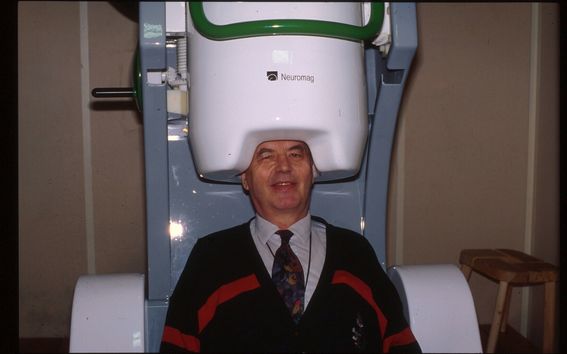
The Low Temperature Laboratory (LTL) of Aalto University, in 2012 renamed Olli V. Lounasmaa Laboratory, is a significant success story of Finnish science. The laboratory was founded by the Finnish physicist Olli V. Lounasmaa (1930-2002) as a research unit of Helsinki University of Technology in 1965. Lounasmaa also led the laboratory until his retirement in 1996.
The experimental verification in 1973 of Helium-3 superfluidity in extremely low temperatures was an achievement which brought Lounasmaa and his laboratory to a wide recognition among the world’s physicists. This result was made possible with the researchers’ hard work as well as through wide international cooperation. The story of such achievements is evidenced by archival documents left behind by Lounasmaa and by the institution which he founded and led.
The Archives of Aalto University hold archival collections from first few decades of the LTL’s operation, as well as the personal archive of Lounasmaa. The record inventories for the Lounasmaa Archive, as well as for other such private archives preserved at Aalto University Archive, may be found at the Aalto University website. A portion of the LTL photo collection can be explored digitally at Aalto University Archives Finna web portal.
Olli Lounasmaa and the Low Temperature Laboratory: A Success Story of Physics Research
The Low Temperature Laboratory at Otaniemi has through its decades achieved results in cryogenics (that is, low-temperature physics) that have been significant on both Finnish and international scale. The Laboratory’s research has spanned subjects falling under cryogenics such as superfluidity, superconductivity and energy levels in atomic nuclei as well as, from 1980s onwards, development of MEG brain scanning technology under the leadership of neurophysiologist Riitta Hari. Increasingly, cryogenics research at the Laboratory has been connected with the development of quantum computation. The first three decades of the Laboratory’s operation are personified in the figure of Olli Lounasmaa, who led the laboratory with determination.
Olli Lounasmaa"A top research unit isn't simply founded, it has to be allowed to be born."
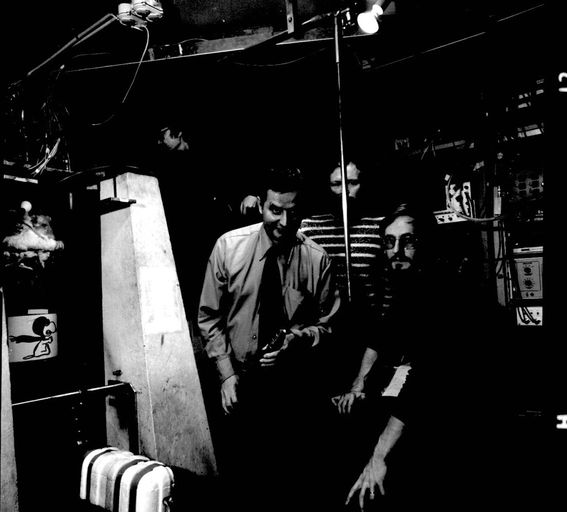
In his personal and professional memoir Täällä ei näperrellä! Kylmäfyysikön kuumat paikat [Freely translated: ”We Don’t Fiddle Around Here! A Low Temperature Physicist in a Hot Spot”, Suomen Tiedeseura 2008] Lounasmaa wrote about the founding of the laboratory: “[Research in cryogenics] fits a country like Finland, that is small but wealthy. It is typical in cryogenics, that researchers need to build their own equipment, so that a relatively meager investment is enough to get by”. Indeed, under Lounasmaa’s direction, the LTL managed to acquire a significant role in cryogenics at the turn of the 1970s, when the research of low temperature phenomena was just getting hot.
In his memoir Lounasmaa came to lament just how close the researchers at the LTL were to achieving a result worthy of a Nobel price – discovery of the superfluid phase transitions of Helium-3.
For just that discovery David M. Lee, Douglas D. Osheroff ja Robert C. Richardson of Cornell University, USA were awarded the 1996 price. However, in its press release the Nobel Committee came to recognize the significant role played by Lounasmaa and the LTL in the experimental verification of superfluidity in the newly found phases of Helium-3: ”That the new liquid really was superfluid was confirmed soon after the discovery, among others by a research team under Olli Lounasmaa at the Helsinki University of Technology.” This result was achieved using a self-built cryostat (cryogenic cooling device), which employed a novel cooling method called Pomeranchuk cooling.
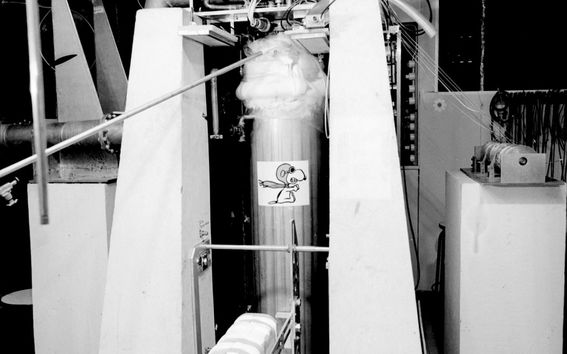
The Low Temperature Laboratory Archive as a historical source
The Aalto University Archives curates the archival collections of both Lounasmaa and the laboratory which he led. Permanently stored archival collections are vital means by which memories of the historical past are stored for posterity. One might say, what laboratories are physicists, archives are for historians.
Even as physics itself is widely considered an exact science, the history of physics as a discipline is that much more open for interpretation. The historiography of natural sciences is filled with arguments about the first discoverer of this or that result. These priority disputes, like for example the argument over Albert Einstein’s and his peers’ (notably the mathematician David Hilbert’s) role in the development of the theory of relativity, have in the past aroused fiery passions.
The researchers of the aforementioned dispute have in the past dove in archives in Göttingen, Germany (Hilbert Archive) and Jerusalem, Israel (Einstein Archive) in search for the historical truth, while simultaneously defending their past colleagues’ honor as scientists. However, in the case of the discovery of the phase transitions in Helium-3, one can not in good conscience talk about a priority dispute: Olli Lounasmaa and his laboratory did lose the race. In his memoir, Lounasmaa laid the blame for this failure on the “squandering” of valuable time in preliminary research on the phenomenon called Kapitza resistance (interfacial thermal resistance). He despaired: ”If I had never heard of Kapitza resistance (--) we could have well caught up to Cornell (--)”! The LTL archive includes the research unit’s official minutes, which show the administrative side of the laboratory’s operation, including decisions related to research priorities. These documents tell their share of the story of the laboratory’s successes, and perhaps also its missteps.
Aside from simple chronological facts, archival study may also tell us about the more complex social factors which underlie the making of scientific research. This in turn may aid the shapers of today’s scientific policy in their judgements. In the 1990s, by then an older and well-respected member of the Finnish scientific community, Lounasmaa gave his own opinion on what makes for “top” research in natural sciences. Reacting to perceived failures in Finnish policies, he claimed that "a top research unit isn't simply founded, it has to be allowed to be born." For Lounasmaa, his colleagues, and his students ”birthing” the research unit meant above all hard work in the laboratory for hours on end. Commenting on his strict work morale, Lounasmaa remarked: ”Being a softy and making science do not mix!”
The international nature of research is evidenced in Lounasmaa’s letters
One major element in the success of the LTL, as well as in communicating said success, was the wide international networking of the laboratory’s research work. Lounasmaa had worked in the United States of America already in the early 1960s – at the time USA was, in Lounasmaa’s words, the “Mecca of Science”. Respectively, American physicists, such as John C. Wheatley, a major expert on cryogenics, were later to visit and work in the LTL.
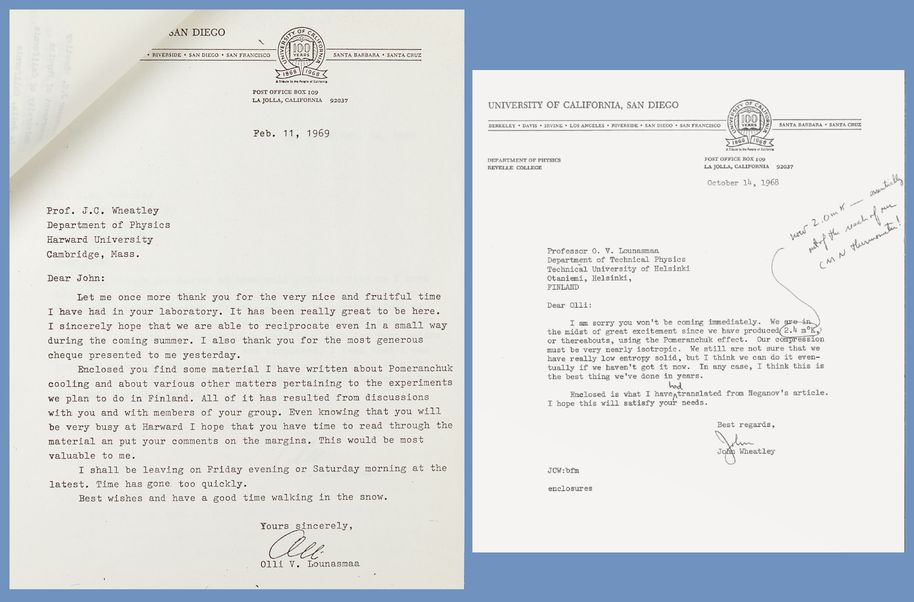
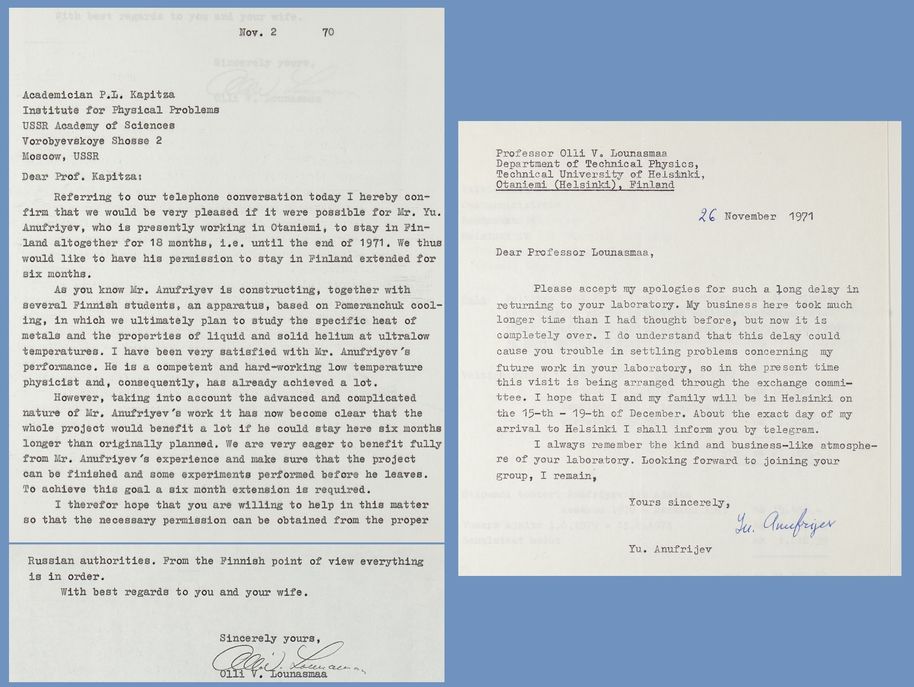
In the Cold War era, the Finnish research community was able to make contact in the East as well as in the West: Cryogenics in the Soviet Union was well established already in 1930s, with experimentalist Pyotr Kapitza discovering the superfluidity of helium’s heavier 4-isotope independently of western researchers, with Lev Landau developing its theory. In 1960s and 1970s, Kapitza was still in charge of the Institute for Physical Problems in Moscow, an institution later to be named after him.
Kapitza was at the time in active professional contact with Lounasmaa in Finland. A Soviet physicist from Kapitza’s Institute by the name of Yuri Anufriyev was a welcome addition to the team at the LTL at the turn of the 1970s. Anufriyev, an expert in Pomeranchuk cooling, was a major help in building the laboratory a cryostat which utilized that cooling method. It was with such a cryostat that the LTL achieved the verification of helium-3 superfluidity in 1973. Unfortunately, whatever their reasons, Soviet authorities had become suspicious of Anufriyev, and from 1972 onwards he was unable to return to Finland from Soviet Union.
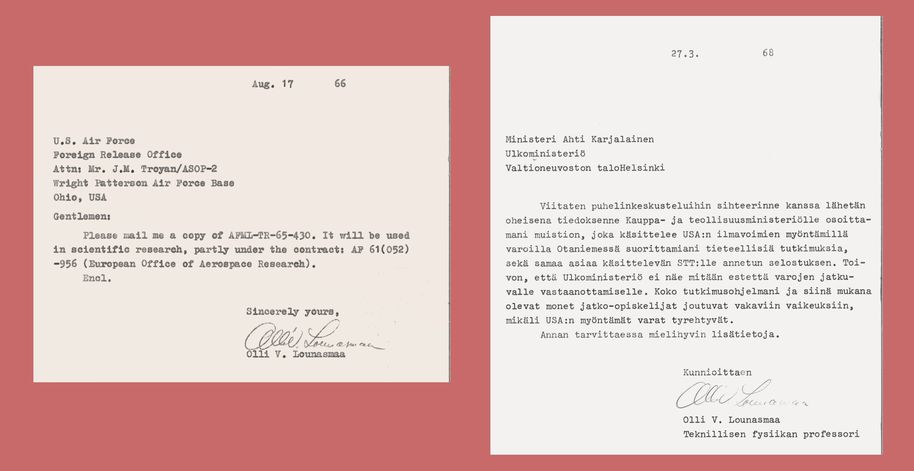
Olli Lounasmaa’s personal archive stored at Aalto University Archives includes Lounasmaa’s wide-ranging, international correspondence. The content of the letters ranges from formal and technical to personal and amiable. Correspondents include mainly his colleagues in physics, like Wheatley and Kapitza, but also, perhaps surprisingly, the United States Air Force.
At the time, the USAF funded research in natural sciences liberally, and in 1965 Lounasmaa successfully applied for such a grant to aid his research. But in Cold War Finland, a country which struggled to maintain a strict neutrality in international politics, the funding of a Finnish researcher by the American military was in 1968 met with public uproar. In public admonishments, a connection was drawn with the ongoing Vietnam War. However, the research conducted by Lounasmaa and the LTL was by no means military in nature.
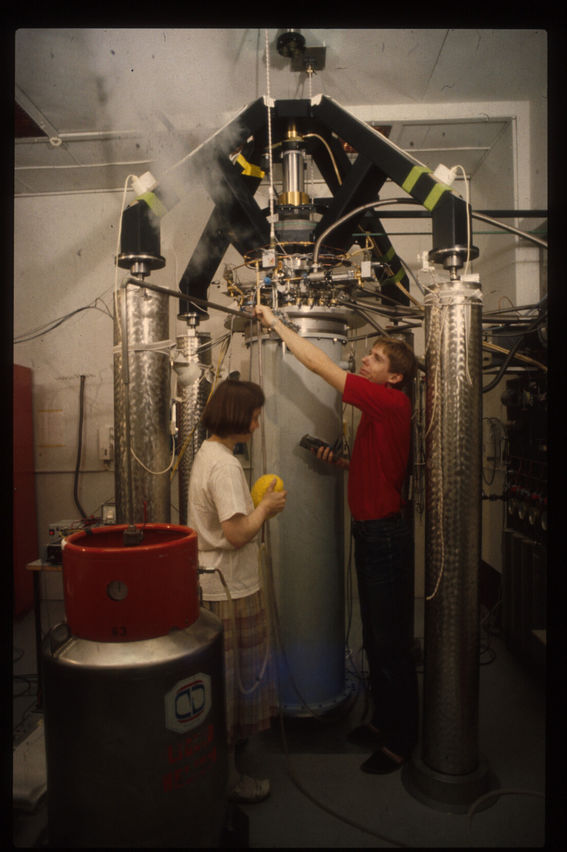
The international nature of scientific research and its consequent connection with international politics is a complex topic which research based on archival material can help us grasp. At the time of writing, said subject is made yet more topical by the ongoing war in Ukraine and its consequences for international cooperation in science. In the historical past, there has often existed an inclination to considered scientific research as being above politics, with scientists sometimes even from countries waging war on one another cooperating. Even so, amidst Vladimir Putin’s exceptionally ruthless crime against peace, the war of aggression in Ukraine, large parts of western and international scientific communities have cut practically all ties to the scientific community in Russia. Aalto University takes part in this wide-ranging boycott.
Written by: Aleksi Kalliokoski






